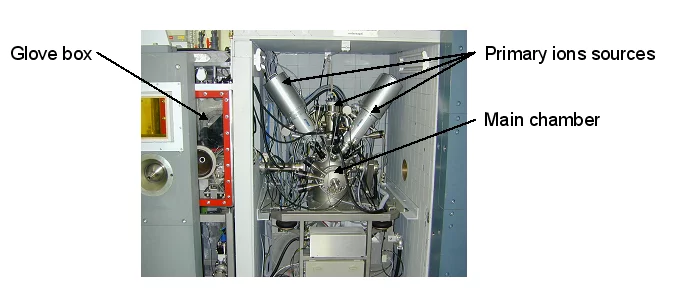Das abgeschirmte ATOMIKA 4000 SIMS wurde 1995 am PSI installiert. Es wurde speziell für die Analyse hochbestrahlter Proben entwickelt, sowohl für Brennstoffe (UO₂, MOX usw.) als auch für Hüllmaterialien (Zircaloy-2, M5 usw.). Die maximal zugelassene Aktivität in der Analysenkammer beträgt 1×10¹⁰ Bq, äquivalent zu 60Co.
Drei primäre Ionenquellen sind je nach Art der Untersuchung einsetzbar: 133Cs+ und (16O2) für Tiefenuntersuchungen (Tiefenprofil) sowie 69Ga+ für Oberflächenuntersuchungen (Ionenabbildung). Die Hauptmerkmale der verschiedenen primären Ionenstrahlen sind:
Energy (keV) | Beam diameter (µm) | Intensity range (nA) | |
|---|---|---|---|
69Ga+ | 25 | 0.3 | 0.01 - 5 |
(16O2)+ | 12 | 15 | 5 - 1500 |
133Cs+ | 10 | 15 | 5 - 1000 |
Die angegebenen Strahldurchmesser entsprechen der geringsten Strahlintensität (Strahlstrom).
Das PSI ist weltweit führend in der Anwendung der SIMS-Technik auf radioaktiven Proben, insbesondere in folgenden Bereichen:
- Quantifizierung von Lithium und Bor in der äußeren Oxidschicht bestrahlter Hüllrohre (durchgeführt mit implantierten Referenzmaterialien).
- Analyse bestrahlter Brennstoffe: Verteilung von Spaltprodukten und Minor-Actiniden-Isotopen entlang des Pelletdurchmessers (Pu-Isotope, U-Isotope, O, Cs, I usw.).
- Untersuchung von Spaltgasen (Xe und Kr): Verteilung der Gasblasen entlang des Pelletdurchmessers.
- 18O-Diffusionsprofil durch die ersten 10 µm des Materials (Festoxid-Brennstoffzellen, SOFC).
Das Instrument wurde Anfang 2012 aufgerüstet. Das Datenerfassungssystem wurde vollständig erneuert. Die Nachweisgrenze der meisten Elemente liegt im Allgemeinen bei wenigen ppm, ist jedoch stark von der Beschaffenheit des untersuchten Materials abhängig. Zum Beispiel beträgt die Nachweisgrenze für 7Li in ZrO₂ etwa 0.5 ppm, während sie für 11B in ZrO₂ bei 10 ppm liegt.

